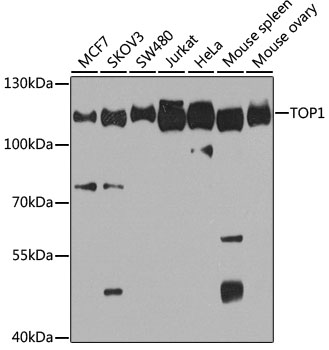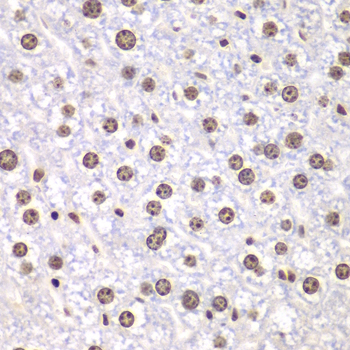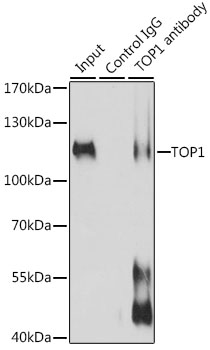-
Product Name
TOP1 Polyclonal Antibody
- Documents
-
Description
Polyclonal antibody to TOP1
-
Tested applications
WB, IHC, IP
-
Species reactivity
Human, Mouse
-
Alternative names
TOP1 antibody; TOPI antibody; DNA topoisomerase 1 antibody
-
Isotype
Rabbit IgG
-
Preparation
Antigen: A synthetic peptide corresponding to a sequence within amino acids 1-100 of human TOP1 (NP_003277.1).
-
Clonality
Polyclonal
-
Formulation
PBS with 0.02% sodium azide, 50% glycerol, pH7.3.
-
Storage instructions
Store at -20℃. Avoid freeze / thaw cycles.
-
Applications
WB 1:500 - 1:2000
IHC 1:50 - 1:200
IP 1:20 - 1:50 -
Validations

Western blot - TOP1 Polyclonal Antibody
Western blot analysis of extracts of various cell lines, using TOP1 antibody at 1:1000 dilution.Secondary antibody: HRP Goat Anti-Rabbit IgG (H+L) at 1:10000 dilution.Lysates/proteins: 25ug per lane.Blocking buffer: 3% nonfat dry milk in TBST.Detection: ECL Basic Kit .Exposure time: 90s.

Immunohistochemistry - TOP1 Polyclonal Antibody
Immunohistochemistry of paraffin-embedded mouse liver using TOP1 antibody at dilution of 1:100 (40x lens).

Immunoprecipitation - TOP1 Polyclonal Antibody
Immunoprecipitation analysis of 200ug extracts of Jurkat cells, using 3 ug TOP1 antibody . Western blot was performed from the immunoprecipitate using TOP1 antibody at a dilition of 1:1000.
-
Background
Releases the supercoiling and torsional tension of DNA introduced during the DNA replication and transcription by transiently cleaving and rejoining one strand of the DNA duplex. Introduces a single-strand break via transesterification at a target site in duplex DNA. The scissile phosphodiester is attacked by the catalytic tyrosine of the enzyme, resulting in the formation of a DNA-(3'-phosphotyrosyl)-enzyme intermediate and the expulsion of a 5'-OH DNA strand. The free DNA strand then rotates around the intact phosphodiester bond on the opposing strand, thus removing DNA supercoils. Finally, in the religation step, the DNA 5'-OH attacks the covalent intermediate to expel the active-site tyrosine and restore the DNA phosphodiester backbone (By similarity). Regulates the alternative splicing of tissue factor (F3) pre-mRNA in endothelial cells. Involved in the circadian transcription of the core circadian clock component ARNTL/BMAL1 by altering the chromatin structure around the ROR response elements (ROREs) on the ARNTL/BMAL1 promoter.
Related Products / Services
Please note: All products are "FOR RESEARCH USE ONLY AND ARE NOT INTENDED FOR DIAGNOSTIC OR THERAPEUTIC USE"
